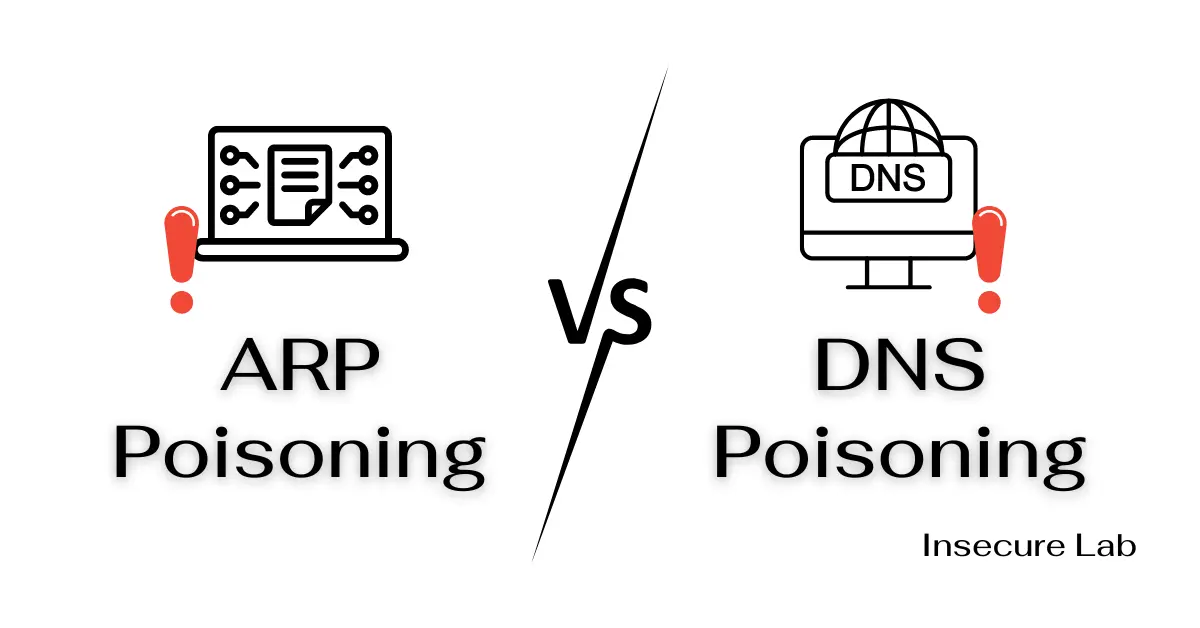Table of Contents
In this comprehensive comparison of ARP Poisoning vs DNS Poisoning attacks we will explore the key differences between them on various aspects of cybersecurity.
ARP and DNS Poisoning Attacks
ARP Poisoning and DNS Poisoning are two types of attacks used in cybersecurity to compromise network communications and redirect traffic for malicious purposes. They both fall under the category of network attacks, but they target different aspects of network communication.
ARP Poisoning
ARP Poisoning, also known as ARP Spoofing, is a type of cyber attack carried out over a Local Area Network (LAN) that involves sending falsified ARP (Address Resolution Protocol) messages onto the network. This attack exploits how ARP functions, enabling the attacker to intercept, modify, or even stop data in-transit.
DNS Poisoning
DNS Poisoning, also known as DNS Spoofing, is a type of cyber attack that targets the Domain Name System (DNS), a crucial component of the Internet’s infrastructure responsible for translating human-readable domain names (like www.example.com) into numerical IP addresses that computers use to communicate with each other. This attack involves corrupting the DNS cache with false information, leading users to fraudulent websites instead of the intended destinations.
ARP Poisoning vs DNS Poisoning
Let’s compare these two network attacks based on various aspects:
Difference Between ARP Poisoning and DNS Poisoning
Below table provides an overview of the key differences between DNS Poisoning and ARP Poisoning attacks on various aspects.
| Aspect | ARP Poisoning | DNS Poisoning |
|---|---|---|
| Definition | Involves sending false ARP messages to link an attacker’s MAC address with a legitimate IP address in a local network. | Involves altering DNS records to associate domain names with malicious IP addresses, redirecting users to attacker-controlled servers. |
| Layer | Data Link Layer | Application Layer |
| Attack Target | Targeted devices within a local network. | Domain Name System infrastructure or caches. |
| Technique | Manipulates ARP cache tables. | Manipulates DNS cache or DNS server records. |
| Attack Vector | Local network-based attack. | Internet-based attack. |
| Objective | Intercept and manipulate network traffic, perform MITM attacks, eavesdrop, and gain unauthorized access. | Redirect users to malicious websites, intercept sensitive data, perform phishing attacks, and hijack user sessions. |
| Method of Execution | 1. Gratuitous ARP: Attacker sends unsolicited ARP replies to map their MAC address to a victim’s IP address. 2. ARP Cache Poisoning: Attacker continuously updates ARP cache tables of victims and routers with fake MAC-to-IP mappings. | 1. Cache Poisoning: Attacker injects fake DNS records into a DNS server’s cache. 2. DNS Spoofing: Attackers set up rogue DNS servers or tamper with DNS responses to point to malicious IPs. |
| Attack Complexity | Relatively lower complexity, typically requires access to the target LAN. | Moderately complex, requires tampering with DNS infrastructure or compromising DNS servers. |
| Visibility | Attack is transparent to the victim. | Users are redirected to malicious sites, noticeable by incorrect website content or security warnings. |
| Impact | 1. Eavesdropping: Attacker can intercept and read unencrypted traffic. 2. MITM Attacks: Attacker can modify or inject malicious content into transmitted data. 3. Denial of Service: Attacker can disrupt network connectivity. | 1. Phishing Attacks: Users can be redirected to fake websites, leading to credential theft. 2. Malware Distribution: Users can be unknowingly directed to download malware. 3. Data Theft: Sensitive information can be intercepted by attackers. 4. Session Hijacking: Attackers can take control of user sessions. |
| Prevention Measures | 1. ARP Spoofing Detection Tools: Network monitoring tools that detect unusual ARP traffic. 2. Static ARP Entries: Manually configure static ARP entries in devices. 3. Port Security: Limit the number of MAC addresses per port. | 1. DNSSEC (DNS Security Extensions): Cryptographically signs DNS records to ensure authenticity. 2. DNS Filtering Solutions: Filter out malicious DNS requests and responses. 3. Regular DNS Cache Clearing: Flush DNS cache to prevent poisoning. 4. Use HTTPS: Encrypt web traffic to prevent DNS-based attacks. 5. Network Segmentation: Isolate critical components of the network. |
| Real-world Example | ARP Cache Poisoning: The Ettercap attack on a LAN, where the attacker gained unauthorized access to network traffic. Gratuitous ARP: Kaminsky’s attack on DNS servers, exploiting a vulnerability to poison DNS caches. | Kaminsky’s DNS Cache Poisoning Attack: In 2008, security researcher Dan Kaminsky demonstrated how attackers could manipulate DNS records to redirect users to malicious sites. |
| Legal Implications | May be considered unauthorized access and a violation of computer crime laws. | Clearly illegal and falls under cybercrime laws, including unauthorized access, fraud, and potential financial losses for victims. |
Conclusion
In the ongoing battle against cyber threats, understanding the differences between various attack techniques is crucial for implementing effective security measures. Both ARP poisoning and DNS poisoning pose significant risks to network integrity, leading to unauthorized access, data breaches, and potential financial losses.
Preventive measures such as regular cache clearing, network segmentation, encryption, and employing security tools are essential to mitigate the risks associated with these attacks.
By staying informed about these attack methods and employing robust security practices, individuals and organizations can better protect their networks, data, and user interactions from these insidious threats.

